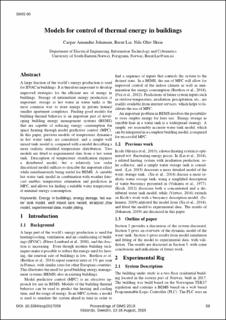| dc.contributor.author | Johansen, Casper Amandus | |
| dc.contributor.author | Lie, Bernt | |
| dc.contributor.author | Skeie, Nils-Olav | |
| dc.date.accessioned | 2020-03-05T10:09:59Z | |
| dc.date.available | 2020-03-05T10:09:59Z | |
| dc.date.created | 2020-01-21T11:14:34Z | |
| dc.date.issued | 2019 | |
| dc.identifier.citation | Linköping Electronic Conference Proceedings. 2019, (170), 59-66. | en_US |
| dc.identifier.issn | 1650-3686 | |
| dc.identifier.uri | https://hdl.handle.net/11250/2645432 | |
| dc.description.abstract | A large fraction of the world’s energy production is used for HVAC in buildings. It is therefore important to develop improved strategies for ef?cient use of energy in buildings. Storage of intermittent energy production is important; storage as hot water in water tanks is the most common way to store energy in private homes/smaller apartment complexes. Finding good models for building thermal behavior is an important part of developing building energy management systems (BEMS) that are capable of reducing energy consumption for space heating through model predictive control (MPC). In this paper, previous models of temperature dynamics in hot water tanks are considered, and a simple well mixed tank model is compared to a model describing a more realistic strati?ed temperature distribution. The two models are ?tted to experimental data from a hot water tank. Description of temperature strati?cation requires a distributed model, but a relatively low order discretized model suf?ces to describe the important effect while simultaneously being useful for BEMS. A suitable hot water tank model in combination with weather forecast enables temperature estimation and prediction in MPC, and allows for ?nding a suitable water temperature at minimal energy consumption. | en_US |
| dc.language.iso | eng | en_US |
| dc.relation.uri | http://www.ep.liu.se/ecp/170/009/ecp19170009.pdf | |
| dc.rights | Navngivelse-Ikkekommersiell 4.0 Internasjonal | * |
| dc.rights | Navngivelse-Ikkekommersiell 4.0 Internasjonal | * |
| dc.rights.uri | http://creativecommons.org/licenses/by-nc/4.0/deed.no | * |
| dc.title | Models for control of thermal energy in buildings | en_US |
| dc.type | Peer reviewed | en_US |
| dc.type | Journal article | en_US |
| dc.description.version | publishedVersion | en_US |
| dc.source.pagenumber | 59-66 | en_US |
| dc.source.journal | Linköping Electronic Conference Proceedings | en_US |
| dc.source.issue | 170 | en_US |
| dc.identifier.doi | 10.3384/ecp2017059 | |
| dc.identifier.cristin | 1779034 | |
| cristin.ispublished | true | |
| cristin.fulltext | original | |
| cristin.qualitycode | 1 | |

